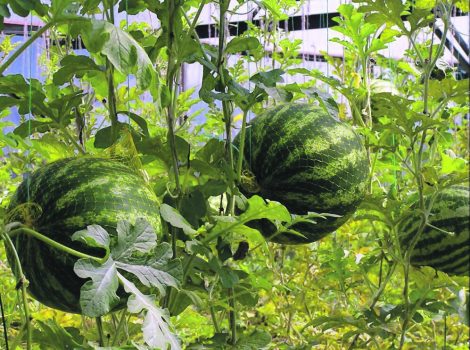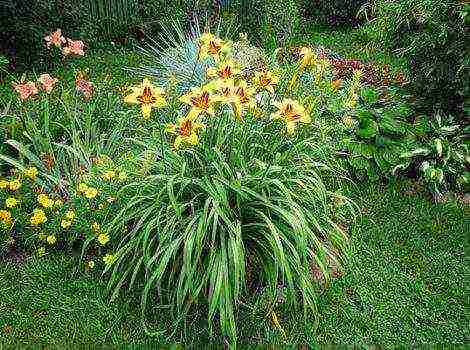Content [show]
Grapes are traditionally considered a southern culture. But how can you stop growing grapes in temperate climates? It is for lovers of viticulture in the northern regions that breeders have bred the cold-resistant grape variety Isabella. As it turned out, it is not only cold-resistant, but also resistant to many diseases and gives stable yields every year.
Isabella grapes: variety description
Isabella is a non-covering tall variety, perfectly adapted to the temperate climatic zone and yielding from the end of September to November. It grows well even in Siberia! Isabella's vine can withstand temperatures as low as -27 degrees.

The bunch of Isabella variety has a cylindrical-conical appearance. Small dark blue berries have a regular spherical shape. The skin is thick and easily separates from the pulp. The pulp is greenish, sweet and sour, slimy, containing from 2 to 5 seeds.
The variety is resistant to many fungal diseases, easily tolerates both drought and high humidity, and is able to grow on almost any soil.
Isabella stands out for its nutritional qualities. The benefits of this grape variety have been known since its inception. The berries contain a large amount of vitamin C, and the peel contains antioxidants that slow down oxidative processes in the body.
Open field planting technology
In central Russia, Isabella grapes are grown everywhere. Planting and care is very simple and does not cause difficulties even for novice gardeners. In addition, the variety is very easy to propagate.
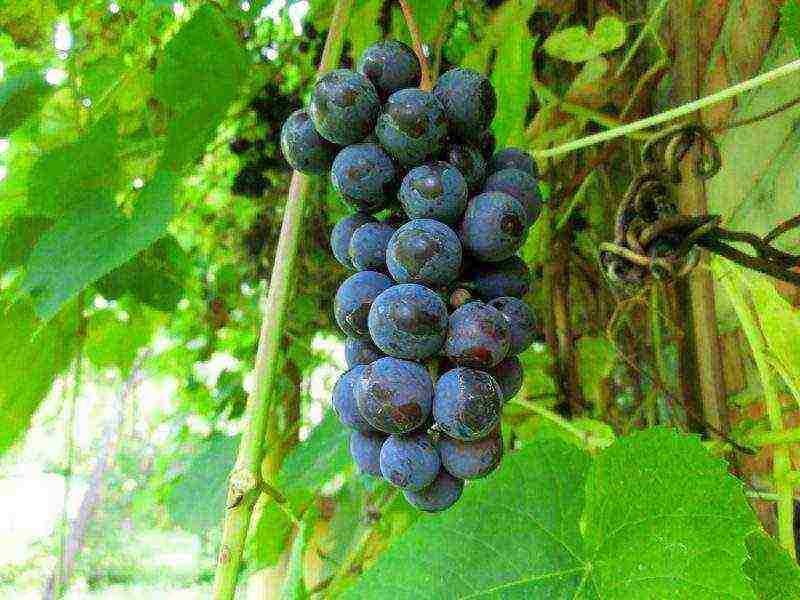
- Isabella is placed in a sunny and warm area. Lowlands, places with a close occurrence to the surface of groundwater, and swampy areas are not suitable for this. Vines can be planted along fences, but the plant itself should not be planted close to them.
- Isabella is planted both in autumn and spring. All other things being equal, an autumn planting in September is preferable, so that for the remaining 1-2 months before the winter cold, the roots have time to consolidate in the soil. If the procedure is performed in the spring, then it is better to choose the first half of May for this, however, if the weather forecast is unfavorable, the landing can be postponed until the second half of the month.
- Saplings are usually obtained from rooted cuttings. For each of them, a hole is dug about 0.8 x 0.8 x 0.8 m in size.A layer of drainage from expanded clay, pebbles, crushed stone, stones or coarse sand is laid on the bottom, sprinkled with small layers of soil, then compost, wood ash, 200-300 grams of superphosphate are added to the pit. After that, the pit is covered with fertile soil, and a seedling is planted in its center.
- In the future, the vine is allowed either along the fence, or along special supports, which are pillars located at a distance of 2-3 m from each other, connected by ropes or wire in 2-3 rows. The lower row is located at a height of 0.5 m from the ground, and the upper row is up to 1.5 m.
Important! If rooting took place in a greenhouse or at home, then by the time of planting, the stalk grows thin fragile leaves, which quickly get sunburn in the open air. Therefore, it is recommended to shade the vineyard for the first 4-5 weeks until coarser leaves grow.
Caring for Isabella grapes in the garden
Despite the fact that the Isabella grape tolerates drought, it gives large yields with periodic watering. In clay soils, water is rarely watered, but abundantly, in sandy soils, often, but moderately. On average, in the absence of rain in the summer, it is watered every 7-10 days.
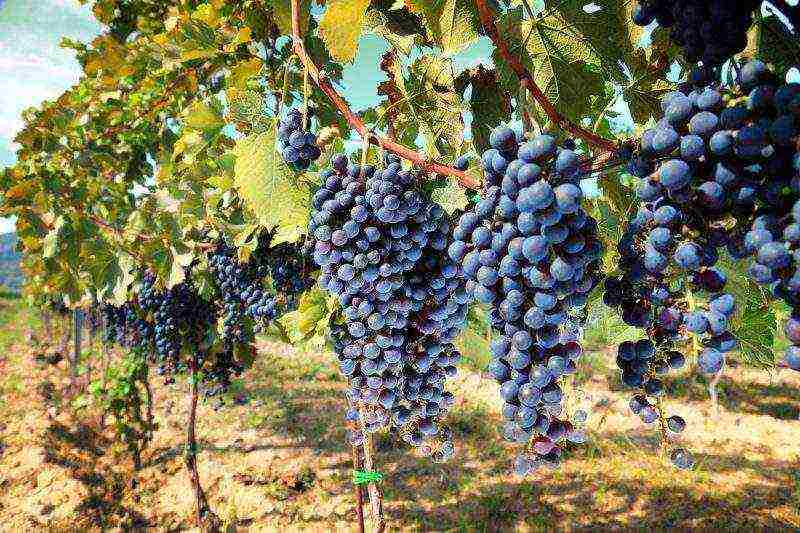
At the same time, it is important to ensure that a dense cracking crust does not form on the soil surface after watering. For this, it is recommended to mulch the ground around the trunk. As mulch are excellent: straw, sawdust, cut grass, dry leaves, tops.
Isabella grapes practically do not need fertilizing, especially if compost and fertilizers were placed in the pit during planting. But if desired, in order to increase yields from the 2nd year after planting, you can feed it 2-4 times per season with complex fertilizers with approximately the same amount of nitrogen, phosphorus and potassium. You can fertilize the vineyard for the first time at the beginning of May, and the last top dressing can be done at the end of August.
How to form vines correctly?
Isabella is a fast growing bush prone to branching. Therefore, it is recommended to prune it either in late autumn, when the vine has shed all the leaves, or in the spring before bud break. General rule of thumb: the vine should have 6-8 healthy shoots.

Important! Pruning correctly increases yields and reduces the risk of developing fungal diseases.
Pruning and covering Isabella grapes in the fall
The procedure must be performed in the interval between the end of the leaf fall and the first frost. To do this, use a special grape pruner.

The rules for pruning grapes in the fall are quite simple:
- all non-lignified and weak shoots are removed;
- lignified branches are cut 2/3 of the length;
- diseased and damaged branches are completely removed.
The cuts are made straight, not oblique, no burrs or cracks in the bark should remain on them. They are smoothed out with a sharp blade if necessary.
Disease and pest control
As a rule, the Isabella variety is not subject to fungal diseases and pest attacks. This can only happen with weakened vines, so the best disease prevention is good grape care.

Of the fungal infections to which Isabella is vulnerable, you can name powdery mildew and mildew (downy mildew).
Powdery mildew resembles a white powdery coating on leaves, stems and fruits. With mildew, the leaves are covered with pale yellow spots with a white bloom, which gradually grow and merge. Sometimes the spots turn brown or gray - this is a slightly different kind of the same disease.
Both true and downy mildew are removed with the help of fungicides, but you need to spray the vineyard carefully, making sure that the working solution gets on every leaf and every shoot. Bordeaux liquid has proven itself well against fungal diseases. Another drug that works well is copper sulfate.
Important! For preventive purposes, 1-2 times per season can be sprayed with Fitosporin.
Of the pests of grapes, only phylloxera can be noted. It is a small but cunning insect that can be easily confused with aphids. Phylloxera differs from it in lemon-yellow color at about the same size. In addition, phylloxera prefers to feed on the juices of the vineyard root system, therefore it is rarely found on the leaves. Unfortunately, there are no effective methods of dealing with this pest, so there is only one thing to do: take good care of the grapes so that they have the strength to resist infection.
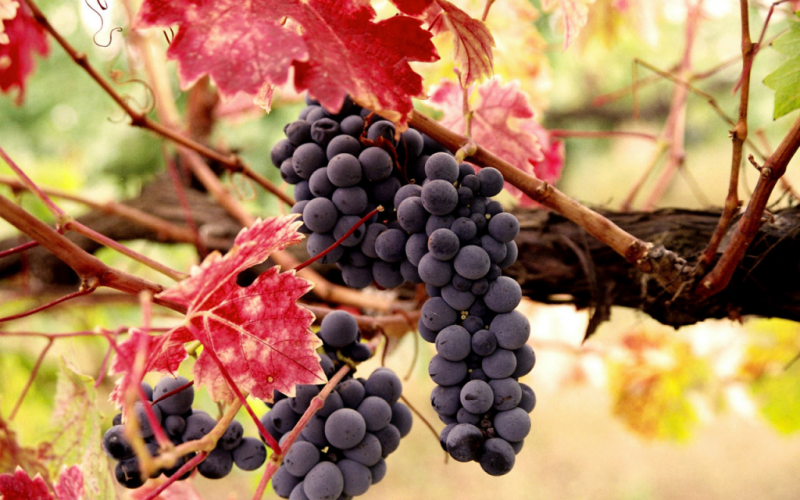
Much less often grapes are affected by ticks, leafworms, aphids, and larvae of May beetle.
In general, Isabella grapes are extremely unpretentious in terms of cultivation. It is able to withstand even harsh winters, while retaining the ability to bear fruit in the new season. Compliance with the elementary rules of caring for him allows you to get bountiful annual harvests.
Over the past decades, grapes in the orchards of central Russia have already become a fairly familiar culture. On the sites of experienced amateurs, the earliest southern varieties, carefully covered for the winter, successfully grow and bear fruit. Breeders have also created special hybrids with increased frost resistance, the cultivation of which is easy even for a novice gardener.
What grapes can be grown in central Russia
By nature, grapes are a heat-loving southern plant. Its advance to the north from the zone of industrial viticulture is hampered by several factors at once:
- low winter temperatures;
- short growing season;
- lack of summer heat.
Nevertheless, over the past half century, in the orchards of central Russia, great success has been achieved in the amateur culture of the earliest southern grape varieties, and sufficiently winter-hardy resistant varieties have been created that can winter without shelter and bring annual stable yields.
Moscow region grapes on video
There are three main areas of northern viticulture:
- growing grapes in greenhouses;
- covering culture of early grape varieties in the open field;
- growing frost-resistant non-covering varieties.
The greenhouse culture did not receive special distribution among amateurs due to its excessive labor intensity and high cost.
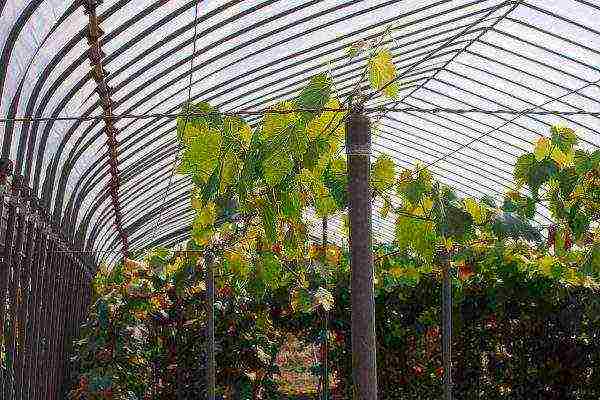
Southern grape varieties can be grown in unheated greenhouses
Covering culture of early southern varieties in the gardens of the middle lane is quite possible, albeit troublesome.
Photo gallery of grape varieties for the middle lane
Grape varieties for central Russia (table)
Isabel (Labrusca) grapes are complex hybrids produced with the North American wild Labrusc grape. Hybrids with the participation of wild Amur grapes, often referred to the same economic group of varieties, are very close to them in their characteristics. Their main advantages:
- increased winter hardiness (up to -35 ..- 40 ° C without any shelter);
- regular and very abundant fruiting;
- high disease resistance (in our area, on the Middle Volga, labrus grapes are not sprayed with anything at all - there is simply no need, he is not sick with anything);
- resistance to phylloxera (this is the worst pest in southern vineyards).
The real Isabella is a very late southern variety. In the middle lane, other varieties are hidden under this name, most often Alpha, as well as unnamed seedlings from varieties of this group.
As for the taste of the berries ... the isabelle varieties have a very peculiar taste and aroma that cannot be confused with anything. Fresh they do not have many fans, but for processing (wine, compote, jam, can be mixed with other fruits and berries) they are very good.
Rumors about the supposedly mortal danger of isabelle grapes are being actively spread by competitors - European wine producers from traditional grapes. At least, the Italians themselves continue to cherish and care for the planting of their famous fragolino (an Italian variety of the isabelle type), not at all intending to get rid of them. And in excessive doses, any alcohol is generally harmful.
Alpha grapes on video
Planting grapes in central Russia
When properly planted in a good location, grapes can grow and bear fruit for many decades without reducing yields.
Selection and preparation of a plot for a vineyard
Ideal vineyard plots in central Russia:
- well-lit and sun-warmed slopes of the southern, southeastern and southwestern directions;
- protected from cold northerly winds by building walls, capital fences or dense forest belts;
- fertile, deeply cultivated sandy loam or light loamy soils, easily permeable to water and air.
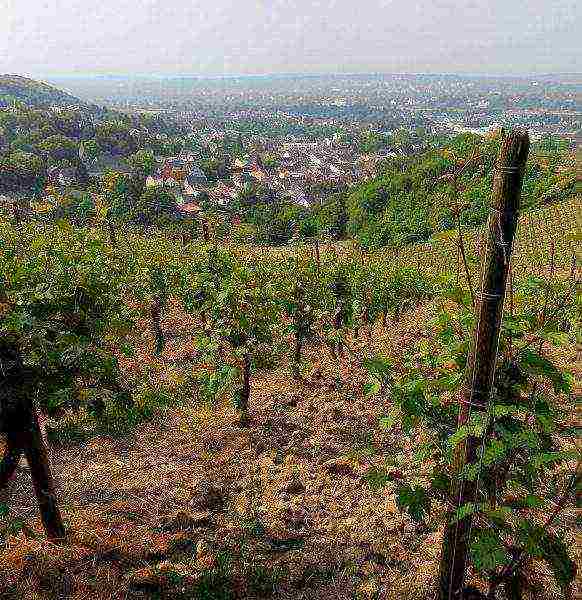
Grapes thrive on warm and light southern slopes
Strongly unsuitable for the vineyard:
- northern slopes;
- areas shaded by buildings or large trees;
- peatlands with close groundwater;
- damp lowlands with heavy clay soil, where water stagnates in spring.
The optimum acidity of the soil should be in the range of 6.5–7.2 for traditional European grape varieties or 5.5–7.0 for complex hybrids of the Labruskov and Amur groups. It is necessary to analyze the soil no later than a year before planting the vineyard, in order to reduce acidity, if necessary, by adding lime or dolomite flour. Lime materials are evenly scattered over the site before deep digging and embedded in the ground. It is impossible to bring them directly into the pits during planting, this can burn the roots of the seedlings.
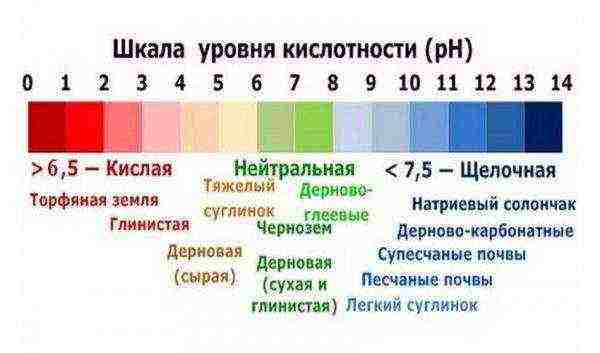
Optimum soil acidity for grapes from 5.5 to 7.2
Arrangement of trellises and arbors
For their normal growth and fruiting, grapes need a reliable support, the frame of which is made of strong metal pipes or wooden beams impregnated with an antiseptic. Winter-hardy non-sheltering varieties can be grown on arbors of any height and configuration. Various supports attached to the south side of the house are well suited for grapes.

Supports for grapes can be conveniently attached to the southern walls of buildings
For covering grapes, it is not advisable to arrange supports higher than two - two and a half meters. When planning the entire structure, there should be sufficient space for the autumn laying of the vines on the ground.
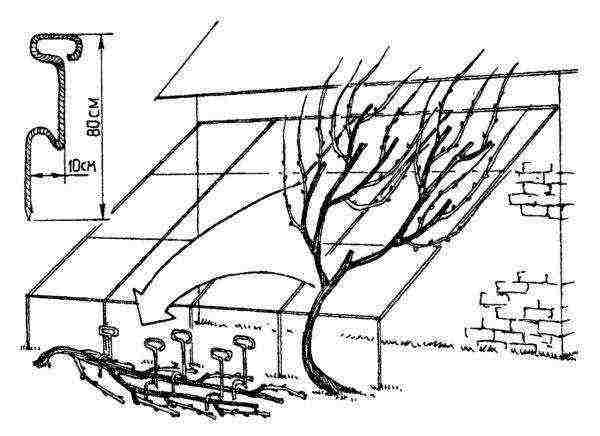
Covering grapes for the winter are removed from the supports and laid on the ground
The simplest support for grapes is a trellis of several pillars with a wire stretched between them. The distance between adjacent pillars is about two meters, they are dug into the ground for at least half a meter, and for reliability it is better to concrete. On long trellises, the extreme pillars must be reinforced in one of the following ways:
- from the outside of the trellis, small anchor posts are dug into the ground under a slope outward, the extreme posts are tied to them with a tightly stretched thick wire;
- the extreme pillars on the inner side of the trellis are firmly supported by inclined additional pillars-stops, the lower ends of which are dug into the ground.
The distance between adjacent trellises should be about two meters. They are placed in the north-south direction so that the grape bushes are better and more evenly illuminated by the sun throughout the day.

The extreme pillars of the grape trellis should be carefully strengthened.
The wire on the trellis is pulled in three or four parallel rows with a distance between them from thirty to fifty centimeters. If the grapes are covering, instead of the traditional wire, you can pull on a strong synthetic rope that can withstand one or even several seasons.
For long-term supports, especially for uncovered grapes, all wooden parts must be impregnated against decay, and the iron parts must have a protective coating against rust.
Selection and planting of seedlings
In central Russia, it is best to plant grapes in spring, from late April to late May. With a later planting, he runs the risk of not having time to root well over the summer. Seedlings should be purchased only in specialized nurseries in your region.
In no case should you plant seedlings of dubious origin brought from the south: firstly, they have insufficient winter hardiness, and secondly, with southern seedlings, you can bring into the garden the most dangerous quarantine pest - phylloxera, which is not yet in central Russia. Any seedlings from an unnamed roadside bazaar are a potential source of danger.
Before buying, check that the seedling is alive, not dried out or rotted. Seedlings with an open root system can only be taken before bud break. Container seedlings can also be with blossoming leaves, in this case, after planting, they need light protection from bright sunlight and possible return frosts.

For planting grapes, deep holes are dug with a drainage layer at the bottom.
- Pits for grapes are needed large, 60–70 centimeters deep and 80–100 centimeters in diameter. It is better to dig them in the fall. The distance between adjacent pits should be at least a meter; to save energy, you can dig holes two to three meters later and plant two seedlings in each from opposite sides of the pit.
- At the bottom of the pit, a drainage layer of broken brick, crushed stone, fragments of slate and other similar materials must be placed. Drainage is especially necessary on loams and clays, where water stagnation is possible.
- On the side of the pit opposite from the future planting site of the seedling, it is advisable to place a piece of asbestos-cement pipe in such a way that its lower end rests against the drainage layer, and the upper one slightly rises above the soil level around the pit. At the top, this piece of pipe must be closed with a lid from a tin can or a cut plastic bottle to avoid the entry of various debris. This system will allow you to properly water the grapes in the future, supplying water to a sufficient depth directly to the roots. The irrigation pipe must not be placed very close to the seedling: in winter, the roots may freeze. The optimum distance from the seedling to the pipe is about 70 centimeters.
- A layer of fertile soil mixed with humus and fertilizers should be poured over the drainage. The approximate rate of fertilizers per pit: 1-2 buckets of decomposed humus or compost, 200-300 grams of superphosphate, 50-100 grams of potassium salt. Nitrogen fertilizers, lime and fresh manure should not be applied during planting.
- In the process of planting, a small mound of prepared fertile soil is poured into the pit, on which it is necessary to lay the seedling with an inclination in the direction where the vines will be laid when sheltering for the winter. Non-covering varieties can be planted vertically.
- The roots of the seedling must be evenly spread to the sides and covered with a layer of earth. With proper planting, the bottom of the seedling (heel) should be at a depth of about half a meter from the soil surface.
- If the buds of the seedling have not yet woken up, you can immediately completely cover it with earth so that one bud remains above the surface. If a seedling with blossoming leaves, it is planted at first shallow, and then, as the shoots grow, the earth is gradually added. For the first summer, all the land taken out during the digging should return back to the pit.
- The planted seedling must be carefully watered with two buckets of water from a watering can with a spray, so that the soil evenly settles and compresses.
- After planting, you can cover the pit with the seedling with a piece of film or agrofibre, pressing the edges of the covering material with stones to the ground. Such a shelter is especially important for early planting of seedlings with already blossoming leaves.
Features of caring for grapes in central Russia
During the summer season, the main concern in the vineyard is to prevent the grapes from turning into an impenetrable jungle. It grows very quickly, and the shoots left unattended get mixed up in a completely unthinkable way.
With winter-hardy, non-covering varieties, everything is simple: shoots growing in the right direction, if necessary, are tied to a support, growing in an undesirable direction, or they are bent back where necessary and fixed on a support in a timely manner, or cut or pinched. The main task in this case is to get a beautiful and uniform green cover on the wall of the gazebo or house. Labrus varieties grow very rapidly, and they yield a crop even in the absence of any formation.

Winter-hardy Alpha grapes grow rapidly, forming a dense green canopy
When working with covering varieties, you always have to remember that in the fall there will be hard work to remove the vine from the supports and lay it on the ground. In industrial viticulture, for each variety, an individual system of forming a bush and normalizing the yield is used, taking into account the design of the trellis, varietal characteristics, the state and level of development of each specific bush. This is how they achieve maximum yields of the best commercial quality. In amateur conditions, especially for novice gardeners, it is enough to get at least a small harvest of their own grapes, which is quite achievable without excessive wisdom.

The Lydia grape is a southern late variety of the isabelle type, in the middle lane almost never ripening to the end
In the climatic conditions of central Russia, grapes rarely need watering, only in the absence of rain for a long time. It is best to water in the wells-pipes established in advance when planting, at least two or three buckets of water for each plant, no more than twice a month (for very young plants in extreme heat, watering once a week with a bucket of water). Frequent shallow watering for grapes is very dangerous: in such conditions, the bushes move to dew roots lying at the very surface of the soil, freezing out during winter frosts. Do not water during flowering (excessive moisture reduces the setting of berries) and at the time of harvest ripening (berries crack from uneven moisture).
Grapes bloom in the first half of June. Damp and cloudy weather during flowering interferes with normal pollination and causes the formation of underdeveloped small berries (the so-called pea grapes).Most modern varieties have bisexual flowers and do not need to be planted with additional pollinating varieties. Flowers and young shoots of grapes can suffer from recurrent frosts, sometimes it is even necessary to cover them with agrofibre, so it is better to place the lower wire of the trellis low above the ground.

During flowering, the grapes are very vulnerable, suffers from troubles and even rains.
The soil in the vineyard must be kept loose and free from weeds throughout the season. Mulching the soil with any organic matter or special agrofibre will help get rid of weeds.
The first two to three years after planting the grapes have enough fertilizers applied to the planting pit when planting the seedling. Mature vineyards are fertilized annually in the spring. It is most convenient to arrange liquid feeding (dosage per 1 adult bush):
- 5 liters of water;
- 30-50 grams of superphosphate;
- 15-20 grams of potassium salt;
- 25-30 grams of ammonium nitrate.
A freshly prepared fertilizer solution is poured into irrigation wells twice a season:
- 8-10 days before flowering;
- 8-10 days after the end of flowering.
In wet rainy weather, instead of a fertilizing solution, dry fertilizers are used in the same doses, evenly distributing them over the entire area of the trunk circle and shallowly embedded in the soil.
In spring or autumn, you can bring half a bucket of well-decomposed compost or humus under each bush, using it to mulch the soil or shallow it into the ground when digging.
The main diseases of grapes:
- oidium (powdery mildew);
- mildew (downy mildew);
- gray rot.
In the middle lane, the first two are very rare. In practice, in most cases, chemical treatments can be dispensed with if you acquire initially healthy seedlings and keep the vines in good condition, in a sunny place and without excessive thickening. Rotten brushes in a rainy autumn can be simply cut off with a pruner and buried deeper into the ground outside the site. Labrusk varieties do not get sick at all. There is no terrible phylloxera (grape root aphid) in the middle lane yet. Therefore, northern grapes can and should be environmentally friendly.
Shelter grapes for the winter
In the fall, after the onset of the first frost, the covering grape vines must be removed from the supports and laid on the ground for shelter. The youngest plants of even winter-hardy labrus varieties can also be laid on the ground and slightly covered for reliability. The simplest shelter is a piece of fiberglass or agrofibre, laid on top of the vine and crushed by stones along the edges so that it does not blow away by the wind.

The simplest shelter for grapes is to lay the vine on the ground and cover it with a piece of fiberglass, pressing the edges with stones to the ground
Non-resistant varieties must be covered more thoroughly:
- Remove the vine from the supports; Tear off the leaves carefully and carry them into the compost heap, if they have not crumbled on their own.
- Lay a coating not subject to decay (plastic, fiberglass, roofing material) on the ground near the bush, carefully lay the vine on it, without breaking it.
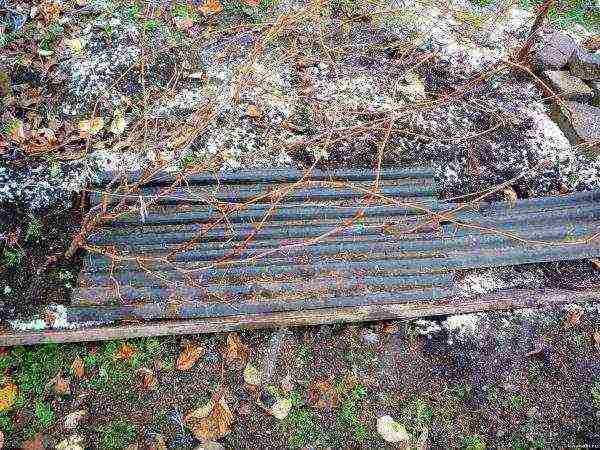
The grape vines are laid on a non-rotting litter
- Secure the grapes on the ground with hooks or low arcs. You can loosely tie the vines into a bunch.
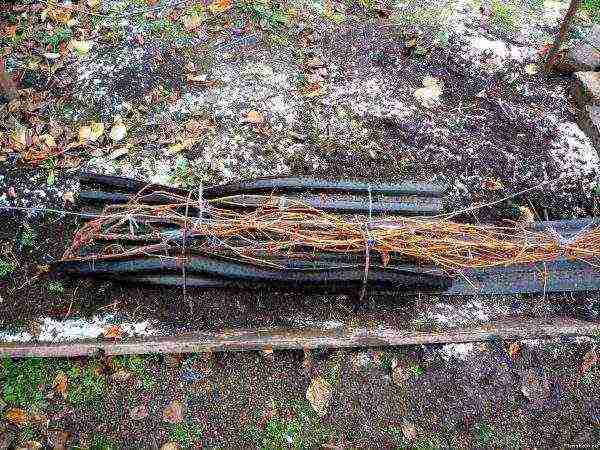
The covered grapes must be fixed to the ground; for convenience, the vines can be loosely tied together
- You can additionally insulate the grapes with coniferous spruce branches or reed mats. Insulation should not rot from moisture or attract mice, so straw and sawdust are not suitable.
- Put arcs on top and cover with a dense plastic wrap so that a small air space remains under the shelter. Press the edges of the foil with stones and sprinkle with earth.This should be done when stable temperatures are established around zero or a couple of degrees below.
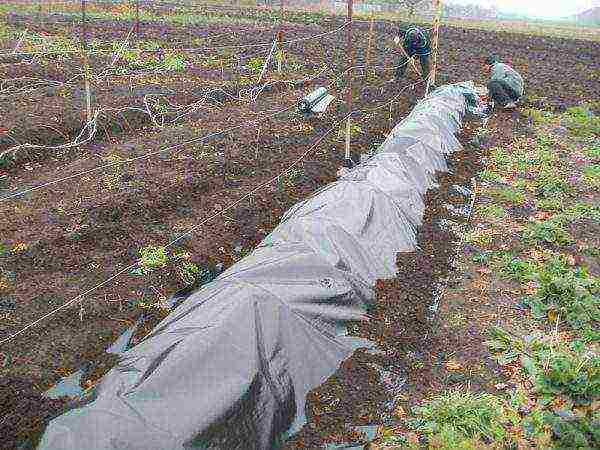
Then the grapes are covered in arcs with dense polyethylene, sprinkling its edges with earth
Winter damping off during thaws is no less dangerous for grapes than frosts. Therefore, one should not rush to cover, and during long winter thaws, ventilation may be necessary, for which the film is slightly raised from the ends.
In the spring, the shelter must be removed immediately after the snow melts. At first, the grapes can be left open for a short time, but not tied up, so that, if there is a threat of frost, it is easy to cover it with a film or agrofibre.
Autumn pruning reduces the winter hardiness of the grapes. In the spring, during sap flow (just before budding), pruning is also dangerous - there will be a strong "cry" of the vines, which is very depleting of the plants. The optimal pruning time for the middle strip is immediately after bud break, when the sap flow has already ended, but the leaves and shoots have not yet begun to actively grow. When pruning grapes above the bud, be sure to leave a stump of two to three centimeters. The first step is to cut out everything that has dried up, broken and rotted during the winter, as well as excess and weak shoots. If there are enough good healthy vines left, too long ones can be shortened, and some of the oldest ones can be cut out altogether.
After pruning, the grapes are tied to a support, trying to distribute more or less evenly over its surface, taking into account the expected summer growth of shoots.
Reviews
Growing grapes in central Russia is not particularly difficult if you choose the right variety and place for planting. A huge advantage of this region is the absence of dangerous quarantine pests that annoy the southern vineyards. And the most winter-hardy hybrid grape varieties grow well even among novice gardeners, not requiring either winter shelter or complex care.
Growing grapes is of interest to many Russian gardeners. Someone wants to prove to themselves that they can cultivate a capricious exotic culture in adverse conditions. Someone is pursuing the goal of becoming a winemaker with production from their own raw materials. Let's figure out when grapes are planted in the middle lane, which variety to choose, and how can the harvest be?

Growing grapes is of interest to many Russian gardeners
Grape classification
Commoners divide varieties into white, black and red. Someone else knows "kish-mish". A gardener who plans to start growing needs to know a deeper classification. Understanding the grape varieties will allow you to choose the one that best suits your needs.
How to choose grapes for planting? Check out the following gradations:
- Ripe fruit taste
- Grape bunch color
- Low temperature stability
- Harvest amount
- Probability of no crop
- Ripening rate
Each of the presented attributes is important when choosing a variety for growing grapes in the middle lane. Professionals recommend that novice gardeners choose early or super-early varieties. They are less capricious in terms of grooming, ideal for beginners and bear fruit 100-120 days after the first buds appear.
Grapes in the middle lane are normal
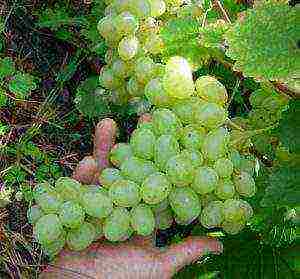
Grapes love water and are afraid of excess heat
The last decade has seen global warming around the globe. Renowned wine and cognac producers are moving their vineyards to the northern regions.
Grapes love water and are afraid of excessive heat. On the Sicilian plantations, the berries dry out without having time to gain juice. French wineries are forced to relocate production to the north.
Therefore, in Russia now it is possible and necessary to grow ripe bunches. It is enough to choose a suitable variety, fertilize it correctly and water it in accordance with weather conditions.
Ideal time for planting grapes
In the middle lane, it is customary to plant grapes in the spring.There are many reasons for this. First, our winters are still cold. Most young autumn seedlings will freeze.
The second is the abundance of water in the soil after the snow melts. Grapes need more water, they still need to be watered. But it is good when there is a certain soil moisture reserve.
And the last thing. Planting grapes with seedlings in spring is convenient because the soil is ideally prepared at this moment. It is not as hard as in autumn or summer. She is not cold as in winter. Over the winter, the soil has accumulated a sufficient amount of useful minerals and trace elements for new plants.
How to plant grapes
The most popular and easiest way to plant grapes is "planting by cuttings".
Cuttings of this perennial plant have a very useful property for gardeners - restoration. They perfectly develop their roots in the soil, retaining all the characteristics of the grapes from which they were cut.
The advantages of "cuttings":
- It's comfortable. The gardener does not have to worry about young seedlings that may die for one reason or another. Grape cuttings are very strong and resistant to temperature changes.
- You can find out in advance which grape variety will grow, what taste and astringency it will have. How strongly it will be suitable for the manufacture of noble wines and cognacs.
- If the acquired stalk was cut from grapes that felt good in the middle lane, then your grapes are likely to grow and bear fruit successfully.
The process of planting cuttings is extremely simple:

The process of planting cuttings is extremely simple
- Buy the cuttings you want from a good gardener
- Find out when they were cut. Cuttings are cut either in the fall or in the spring a couple of weeks before flowering. The former have strong immunity from external stimuli. Young cuttings grow much faster and gain strength.
- Before planting, cut off all leaves, growths, tendrils and other elements unnecessary for new grapes from it.
- The ends of the cuttings should be cut off under the knot to speed up the water saturation of the new plant.
- For a day, you should put the cuttings in water
If you bought autumn blanks and plan to plant them in the spring, then after the initial processing, leave them to lie in a dry and cool place for the winter. Dryness will not harm a perennial, but moisture can quickly cause suppuration. When spring comes, plant the cuttings along with the young seedlings.
If you decide to grow spring cuttings from fresh plants, then simply plant them along with old cuttings at the same time.
Grape varieties for our climate
Which grapes are the most effective for planting in the middle lane? We have already determined that early maturing varieties are best for us. How many are there? Let's get a look.
Isabel
One of the most popular grape varieties among Russian farmers. It is delicious, has a wonderful aroma, and is suitable for making wines. Isabella is an unpretentious variety that can be grown even in harsh climates. Frost-hardy grapes are a godsend for our unpredictable temperatures.
Pros:
- Expressive sweet taste
- Memorable scent
- Unpretentiousness when growing
- Isabella wine is very popular
Minuses:
- Not everyone likes the taste and smell because of their specificity.
- Small berries
- The bunches are weak, the grapes may crumble
Moldova
One of the best selected grapes, which gets along well in cold climates, rarely dies from unfavorable weather conditions, and has a good taste. This variety is not early maturing, the harvest period is 160–170 days after the start of flowering. It is grown in order to harvest in September before frost.

Moldova is one of the best selected grapes
Pros:
- Large and weighty bunches
- Suitable for our conditions
- Bushes are strong and thick, well protected from external factors
- Fleshy pulp
- Large berry size
- A lot of crops with proper care during ripening
- The berries have a thick but tender skin. This allows it to be tasty and carry long-distance transportation and not spoil.
- The grapes are self-pollinated
Minuses:
- Planted grapes must be treated with special preparations against powdery mildew. Moldova is prone to this disease, which can ruin every vine in your vineyard.
- Variety requires good yield distribution and shoot distribution
- Moldova does not tolerate "crowding"
Kesha grapes
Kesha is an early grape variety that ripens a little over 100 days after the first flowers appear. In general, there are several types of Kesha, they do not differ much, but a competent gardener can even visually distinguish them. Let's find out which one to plant in your spring vineyard.
Classic Kesha
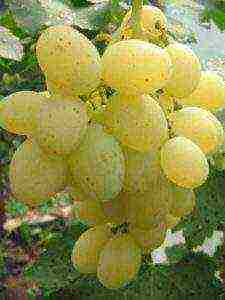
The Kesha variety has large clusters with equally large berries
When people plant grapes in the middle lane, they try to adhere to a number of factors when choosing a variety: yield, taste, number of seeds, predisposition to diseases.
The Kesha variety passes all these tests with confidence. The grapes are white, have large clusters with equally large berries. It is sweet and aromatic. Diseases bypass him, in comparison with the same "Moldova".
Kesha-1
It differs from the parent in that it matures a little longer. The advantage is an even larger bunch and berry. The most unpretentious grapes of all that are described in the material. Sometimes it is also called "Talisman"
Kesha-2
This variety has many different names, but the essence is the same: Tamerlane, Muscat Kesha or Zlatogor. The peculiarity of the second Kesha is its nutmeg flavor, thanks to which it received another additional name. The earliest of all Kesh, grows in 110 days. If summer is warm, it can grow even faster.
All Keshas are very dependent on the sun. Therefore, they should be planted in open areas, not locked between the walls of houses or tree crowns. The more sun in summer, the tastier the fruits will grow.
Variety "Anyuta"
Not the easiest option for a novice gardener, but very interesting for those who have already dealt with grape crops. Anyuta is a selection variety that came from Kesha-1 and ordinary Kishmish.
Such grapes are usually liked by those who, for whatever reason, do not like sweet white grapes and sour Kishmish. This is a really interesting cross that is appreciated in the markets.
Positive points:
- An average unobtrusive taste that may please even those who do not like grapes
- Ability to withstand severe frosts (up to - 25)
- Very high fertility and productivity
- Fleshy berries that can even burst in the rain
- Long shelf life
No one notes the minuses among those who cultivate this variety. If you find fault, then we can say that the variety does not have its own distinctive feature. It is extremely ordinary. Ardent connoisseurs of grapes do not recognize it, do not consider it tasty, but they do not call it tasteless either. Yes, and there are bones in it, which many may not like.
For a start, these types of grapes will be enough for you, then you can try other, more complex and unusual options. Real masters become breeders themselves and give the world new varieties.
Growing errors
At the initial stage, you can make a mistake in any business. Let's take a look at the most common ones to minimize the likelihood of failure.
- It is necessary to check the roots of the seedlings before planting. If they turn out to be weak, they will not withstand bad weather conditions. You shouldn't expect a good harvest from them either.
- Buy seedlings and cuttings of famous varieties. Only a clear understanding of the growing algorithms will allow you to get really good berries.If the variety is generally not suitable for the middle lane, then the result of the whole event will be disastrous.
- Any grape loves a spacious area. There are those who grow it in a confined space, near a wall, this is wrong. Strong clusters are obtained when nothing constrains them.
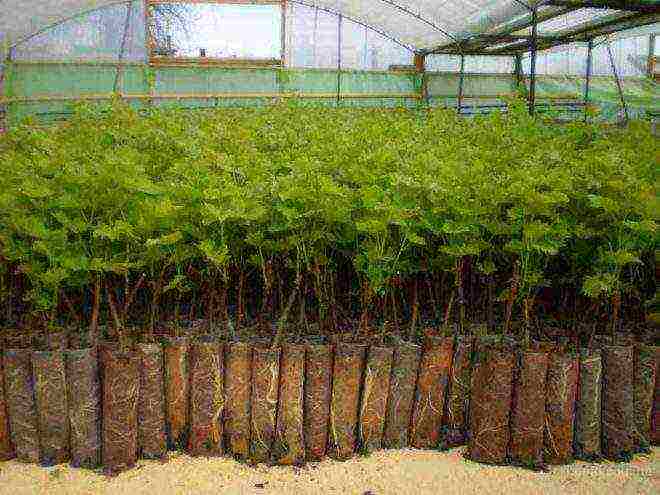
It is necessary to check the roots of seedlings before planting
- Landing should be done in deep holes, at least 15 centimeters deep. If you neglect the depth, then the grapes will not receive the necessary moisture from the soil and nutrients.
- The grapes have male and female varieties. Some of them may be bisexual. Asexual has no pollination problems. And if only female varieties are planted, then the amount of the crop will be significantly reduced. Many beginners miss this moment, then they cannot understand the reason for the poor fertility of good bushes.
conclusions
Many gardeners believe that only pears and apples can be grown in our gardens. The countless vineyards in the middle lane prove otherwise. We can do without imported berries, just want to.
You need to choose the right grape variety that you like and will be unpretentious to plant diseases and bad weather.
Be aware of your goals immediately! Hybrid grape varieties, such as Anyuta, are suitable for nutrition, but inexpressive in the production of wine and other beverages.
Choose the right seedlings and cuttings, use the experience of generations. So, you will get a good result in your endeavor.
Plant grapes in spring when the land is well prepared for planting and the weather conditions are not detrimental to green seedlings. There are varieties for autumn planting, but caring for them is specific, evaluate your knowledge before taking such a step.
The less frequent the bushes, the more useful trace elements each bunch of grapes in your garden will receive. The grapes do not tolerate close planting.
Water the plants abundantly at the same time interval, the grapes are very fond of water, especially in summer and autumn, when the soil is not sufficiently moistened.
Study, practice. Diversify your garden, add new varieties, breed your own grapes. You will succeed, as did hundreds of gardeners from central Russia.
How I got rid of herpes with lipstick
Hi everyone! Earlier, for 6 years she suffered from herpes. There were rashes every month. From the experience of dealing with the disease, I can say the following. At first, acycloviros-containing drugs help a lot, and then the effect of the treatment disappears. She was observed in a herpes treatment center, but the treatment was ineffective. Wasted a lot of money and all to no avail.
Having learned about lipstick from herpes, I was skeptical, but still ordered. I used it for a week. I felt the first result after 4 days. Now, not a hint of herpes!
Read the article »>
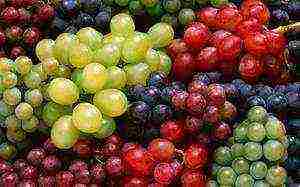 One of the most ancient cultures that people grow is without a doubt grapes., which is also called the berry of life, because of the incredibly large amount of elements useful for our body that it contains. A large number of people have the misconception that the grape vine, which will bear fruit, can be grown exclusively in the southern regions.
One of the most ancient cultures that people grow is without a doubt grapes., which is also called the berry of life, because of the incredibly large amount of elements useful for our body that it contains. A large number of people have the misconception that the grape vine, which will bear fruit, can be grown exclusively in the southern regions.
How to grow grapes in central Russia
At the moment, there is a fairly large number of frost-resistant grape varieties. Thanks to this, in our time there is an opportunity to grow a fruiting vine even in the territory of central Russia.
DEven considering that in the area where you are going to grow grapes, there may be a cold and long winter, and on the thermometer at times you can see a mark of -20 degrees Celsius, all this still should not prevent you from planting grapes... And if you still follow the advice from this article, it can be a good help when growing your grapes in central Russia.
What varieties to grow
 Now almost every suburban area is grown some sort of grape. If this suburban area is not in the south, then most likely Isabella will grow there. This is a rather unpretentious grape variety, the vines of which give a large amount of harvest, and the vines themselves can also serve as an extremely good decoration for a summer cottage.
Now almost every suburban area is grown some sort of grape. If this suburban area is not in the south, then most likely Isabella will grow there. This is a rather unpretentious grape variety, the vines of which give a large amount of harvest, and the vines themselves can also serve as an extremely good decoration for a summer cottage.
However, the berries of this variety are quite small and also have a tart, sour taste. Over the past couple of decades, with the help of the work of selection, a lot of different varieties have been bred that have high resistance to frost, as well as large and sweet fruits. Thus, there is a gigantic selection of grape varieties that are very different in taste, shape and color. From all this abundance of choice, you can choose the most suitable variety for yourself.
You have every right to wait for a good harvest if you bought a good seedling, here is a list of suitable winter-hardy varieties. Varieties ranging from white to pink:
- Crystal
- Laura
- Aleshenkin
- Tsikhmistrenko
- Dessert Muscat
- Muscat
- Delight
- Samara
- Amber
Blue and dark purple shades:
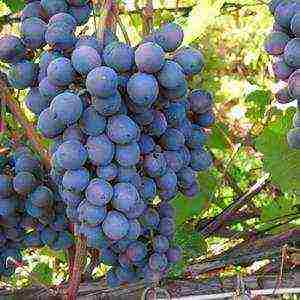 Agat Donskoy
Agat Donskoy- Brother of Rapture
- Cardinal
- Kishmish unique
- Codryanka
- Early purple
All of these varieties have large berries with a wonderful delicate aroma.
Selection of grape seedling and planting site
It would be better to buy grape seedlings either from amateurs engaged in collecting, or from breeders. The most desirable option would be to come to their site yourself in order to see how the vine of the variety you want grows, as well as how this vine bears fruit and what care it needs. This way, you can be sure that you have taken exactly what you need. Spontaneous markets are best avoided. You should adhere to certain rules when buying a grape seedling:
- The purchase is worth making in the spring.
- It is better to purchase from someone who understands grapes and can also share their knowledge and give some advice in terms of care.
- A seedling that is two years old will have a strong root system with a light root color.
- It is necessary to process only purchased seedlings with a double dose of Kinmix or Bi 58 (usual dose). All this is done to protect against grape pests. It happens as follows: the drug itself is diluted in clean water, with the calculation of two milliliters of the drug per ten liters of water. Then we moisten the seedlings in this solution, leave for half an hour and rinse them.
- You need to plant purchased seedlings on the street only during the second decade of the month of June. Until then, they must be stored in perforated paper bags.
- From the beginning of May, you can transplant a seedling from a package into a bucket (5 liters) and put it to grow until June on the south window.

Pick-up location for a vine, you need to choose such that it is closed from the winds from the north, for example, the wall of a house or a barn, or a fence. The place should also be sunny. The soil for planting must have drainage. The arrangement of the rows for the grapes must be chosen from the south to the north. If there is even the smallest slope in place, then it is worth planting grapes on the slopes of the south or southwest.
If the site is flat in itself, but there is no room on the young wall, then there is an opportunity to build a fence, just not higher than a couple of meters, and also make an orientation from east to west. Here the secrets that are used in the monastery vineyards and why they are so fruitful will immediately become available to you. Instead of using a board fence, you can build a tall fence that has good density.
Thus, instead of the unpretentious Isabella or Lydia, which are rather unpretentious, you can grow vines with a good harvest on your site, in the form of large, fragrant and sweet berries that have a rather expressive taste.Such species will grow in the conditions of central Russia, thanks to the labors of breeders.
In addition, the expressiveness of the taste of such a bunch of grapes grown on its site will not be inferior to foreign products.
For beginners, it is recommended to grow early varieties in the middle lane. Ripening of such varieties happens by the middle of the month of August..
Quite popular grape varieties for cultivation in central Russia are also: Muromets, Kesha, Cosmos and Arcadia... All these varieties have large fruits, about the size of a small plum, and besides, they all have a great taste, sweetness, combined with a delicate aroma.
More buying tips
 You should not make the acquisition of a seedling, as they say, in the heat of the moment... That is, if you buy from a nursery, then you should not take the first one that you get. It is necessary to carefully evaluate and weigh everything, look at the price and compare. It will be best if you can take a look at the grown specimens as they bear fruit.
You should not make the acquisition of a seedling, as they say, in the heat of the moment... That is, if you buy from a nursery, then you should not take the first one that you get. It is necessary to carefully evaluate and weigh everything, look at the price and compare. It will be best if you can take a look at the grown specimens as they bear fruit.
Try for yourself the option of purchasing cuttings from an extensive grape growing farm. Try to persuade the owner to give you a short tour. Choose a bunch of grapes that you liked and try it, and after that you can already ask for the cuttings of the grapes you like. By making a choice in this way, you will find exactly what you need, and you will also be able to get advice from the seller.
Material for autumn is usually much more hardy than spring material. Thus, if it tolerates the winter normally, then in the spring it already grows well.
It is better for beginners not to tackle difficult specimens of hybrids right away, since they usually require a lot of attention, and besides, a lot of knowledge, along with experience.
It is better not to store the purchased seedlings, but instead soak them in purified water, and transplant them into the soil one day later.
You should not buy supposedly elite grape varieties in the ordinary market from sellers who are trying to impose their goods on you. This way you will not risk buying something “wrong”.
More about the landing site and process
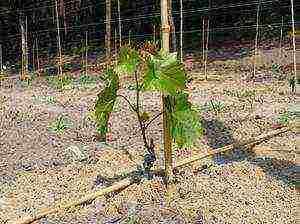
If you want to plant only one bush of grapes, then it is worth choosing a sufficiently sunny place for this, which is far enough from trees and various types of shrubs. These are the characteristics that are suitable when choosing a place for a large vineyard:
- Slope from the east, south or southwest
- The place should be well lit during the day.
- The place should be located at a remote distance from groundwater, as well as swamps
Do not plant the vine on the north side, or under a tree or close to any body of water.
So, how does the planting of grapes take place in the conditions of central Russia? But like this:
- It is necessary to slightly trim the purchased material after it gets wet for 24 hours. The roots are made quite a bit shorter, while the shoot is made three buds less. Side layouts should also be removed, if any.
- The finished seedling should be dipped in the clay solution directly by the roots, then sent to the finished hole or dug trench.
- Much better than any general advice will be recommendations from specialists for your specific case of feeding grapes during the planting process, as well as what depth is suitable for placing the heel of the shank on it and how to choose drainage for your place. These are the recommendations you will get.
- A hill should be made around the sprout itself if planting occurs during winter. When cold weather sets in, you need to cover it with a plastic bottle and cover it with peat or mulch.
- Planting in the spring requires moistening the trench or pit itself. It is necessary to do shading after planting the shanks and making the soil dense. this is done so that the sun does not burn the sprouts in the spring.
- A week after planting in the spring, it is necessary to water the seedlings, and after the soil dries, its top layer must be loosened.
Spring grape care
After the growth of new specimens has begun, together with one-year-old and two-year-old seedlings, it is necessary to complete certain procedures for caring for them. Here they are:
 It is necessary to remove unnecessary weeds under the vine, as well as around the grape bush.
It is necessary to remove unnecessary weeds under the vine, as well as around the grape bush.- Next, loosen the top layer near the soil
- It is also important to prune weak roots twenty centimeters underground each year.
- Spraying the bush with Bordeaux liquid before the growing season begins. This is done in the spring as a preventive measure.
In order to provide sufficient nutrition for already mature seedlings, it is very important to water correctly in the spring and summer. Abundantly, several times. It is necessary to use about fifteen liters of water for one bush at one time. Watering should not stagnate in the root system, because this can cause some kind of fungal disease or even rotting of the root system. Properly organized drainage will help avoid all these troubles. In order to understand the frequency of watering during the summer, you will need to know the temperature regime in your area this summer. In rain or cold, it is allowed to fill the bushes twice. If the temperature in your area is normal, then you can do four waterings.
After rain, your grapes need special attention and treatment. Such treatment is simply necessary after the rain has passed, because high humidity leads to the rapid spread of harmful spores through the seedling. It is necessary to spray the bushes with multipurpose solutions that will help protect the bush from powdery mildew, late blight and mildew.
Pruning
Owners of grapes in central Russia do a global, large pruning twice a year. Such pruning is necessary in the fall, before covering the seedlings for the winter. In the spring, pruning is done after the opening process. Dried and frozen shoots are pruned, in addition, during the growth of the bush, the shoots are pinched and pruned so that the vine is formed correctly.
In order for the bush to form correctly, it is necessary to prune it from its first year. Shoots that break off green in order to prevent them from twisting into branches. On younger seedlings, the flowering branches are removed to prevent the berries from developing. This is done because young seedlings can deplete themselves, due to the fact that they devote all their strength to making the bunch grow. Those shoots that remain, they are given a direction and a garter is made.
During the direction, if you want your bush to grow powerful, it is worth pointing up the shoots that you have left. The correct formation of a grape bush in central Russia with the help of pruning will help make your bush the way you want it to be.
Thus, by following these simple guidelines, you can get the perfect vine for yourself, which will produce sweet, large and aromatic berries..
